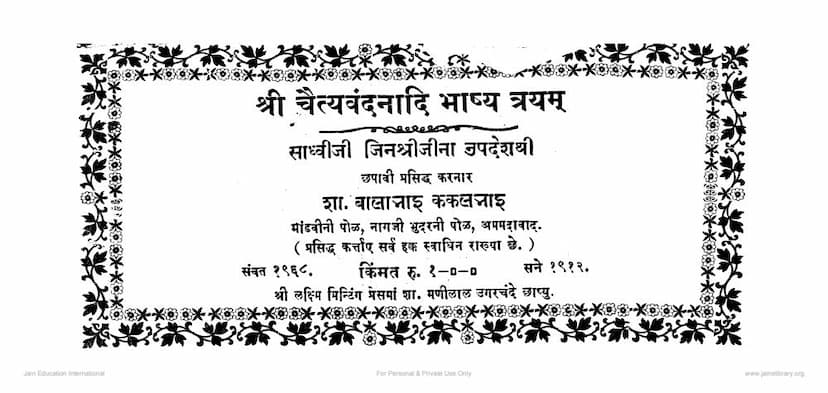Chaityavandanadi Bhashya Trayam
Added to library: September 1, 2025

Summary
This Jain text, "Chaityavandanadi Bhashya Trayam" (Chaitryavandanadi Bhashya Trayam) by Balabhai Kakalbhai, is a comprehensive guide covering three essential Jain practices: Chaityavandana (worship of temples and idols), Guruvandana (veneration of spiritual preceptors), and Pratyakhyana (renunciation or vows). Published in 1912 (Samvat 1968), the book aims to provide a clear and accessible explanation of these rituals for Jains.
The book is structured as follows:
Part 1: Chaityavandana Bhashya (Textual Commentary on Temple Worship)
This section details the intricacies of temple worship, broken down into 24 main "doors" or aspects. Each door elaborates on specific elements and their proper execution. Some of the key aspects covered include:
- Mangalacharana (Benedictory Verses): Commencing with verses of invocation by the author and previous spiritual masters.
- Nishidhi and Pradakshina: The proper place and method for circumambulating the temple and performing other reverential acts.
- Pranamika (Prostration): The correct forms of prostration, including various types of bowing.
- Puja-trika (Three types of Worship): Elaborating on different aspects of the worship ritual.
- Dash-trika and Avastha-trika: Discussing sets of ten and three elements related to the state of the devotee.
- Alambana-trika and Pranidhana-trika: Focusing on the objects of focus and the mental states during worship.
- Danda-ka, Lava-krama, and Abhiegama: Covering specific postures, sequences of actions, and approaches to worship.
- Upayoga-trika and Mudra-trika: Discussing the proper use of senses and symbolic hand gestures.
- Types of Jin and Ayatanas: Identifying different classifications of Jinas (Tirthankaras) and sacred spaces.
- Niyog (Injunctions) and Vairagya (Dispassion): Highlighting practices that lead to dispassion and detachment.
- Dash-Ashata (Ten prohibitions) and Agara (Prohibitions): Detailing actions to be avoided during worship.
- Kaushagga (Meditation): Explaining the practice of meditation, including its correct posture, pronunciation, and potential faults.
- Vitaraaga Stavan (Praise of the Detached Ones): The proper way to compose and recite praises of the liberated souls.
- Number of Worships: Specifying the appropriate number of times to perform Chaityavandana daily.
- Aashata (Taboos): Listing prohibitions to be observed within the temple premises.
The text provides detailed explanations, often referencing specific verses (Gathas) and their corresponding "Shabdarth" (word meanings) and "Arth" (overall meaning). It aims to correct common misconceptions and provide a clear understanding of the ritualistic aspects.
Part 2: Guruvandana Bhashya (Textual Commentary on Veneration of Preceptors)
This section shifts focus to the veneration of spiritual preceptors. It outlines:
- Types of Vandana: Three distinct ways of showing reverence.
- Names of Vandana: Different appellations for the act of veneration.
- Twenty-two Doors of Vandana: A comprehensive breakdown of various aspects and rules related to showing respect to gurus.
- Examples and Illustrations: The text includes illustrative stories to clarify the principles of Guruvandana.
- Five Avandaniya (Things/People Not to Be Worshipped): Identifying individuals or things that should not be worshipped.
- Five Vandaniya (Worthy of Worship): Identifying individuals or things that are worthy of worship.
- Four Reasons for Not Worshipping: Explaining circumstances where worship is inappropriate.
- Four Reasons for Worshipping: Outlining situations where worship is recommended.
- Five Places Not to Show Vandana: Specifying locations where prostration is inappropriate.
- Eight Reasons for Showing Vandana: Detailing the motivations behind veneration.
- Twenty-five Essentials: Actions that are necessary when performing Guruvandana.
- Thirty-two Faults to Avoid: Highlighting common mistakes to be rectified during the process.
- Six Virtues Gained: The positive outcomes of proper veneration.
- Six Places for Guru's Installation: Describing the proper placement for venerating the guru.
- Two Methods of Morning and Evening Vandana: Specific procedures for these times.
Part 3: Pratyakhyana Bhashya (Textual Commentary on Renunciation/Vows)
This final section delves into the practice of Pratyakhyana, focusing on various aspects of renunciation and vows:
- Nine Doors of Pratyakhyana: A detailed exploration of the fundamental elements of taking vows.
- Ten Types of Bhaksha and Abhaksha: Classifying foods that are permissible and forbidden.
- Four Types of Pratyakhyana: Differentiating between various forms of renunciation.
- Four Types of Ahar (Food): Categorizing food based on its qualities and purity.
- Akar (Prohibitions) Related to Navakar: Discussing prohibitions specifically associated with reciting the Navakar Mantra.
- Six Shuddhi (Purities): Outlining six essential aspects of purity in practice.
- Fruit of Pratyakhyana: Explaining the benefits of undertaking vows.
- Ten Viguëti (Things to be avoided): Listing ten specific items or actions to be renounced.
- Thirty Types of Niyata (Abstinence): Detailing thirty distinct forms of abstinence.
- Four Types of Bhanga (Breakdown): Explaining the breakdown or violation of vows.
Overall Purpose and Approach:
The author, Balabhai Kakalbhai, emphasizes that understanding the purpose, reasons, methods, and fruits of any religious practice is crucial for its effective observance. He states that this book is intended to provide this knowledge for the three key practices. He notes that while other books cover these topics, they are either too expensive, too voluminous, or out of print, necessitating this concise and accessible guide.
The book also highlights a pedagogical approach where the meaning of key words is provided at the beginning of each verse to aid comprehension. It acknowledges the assistance of various individuals and institutions in its publication, particularly mentioning the encouragement of Sadhviji Jinshriji.
In essence, "Chaityavandanadi Bhashya Trayam" serves as a practical manual for Jain practitioners, offering detailed guidance on the correct performance of Chaityavandana, Guruvandana, and Pratyakhyana, rooted in Jain scriptures and traditions.